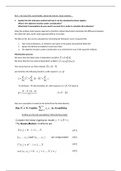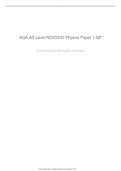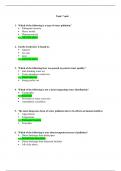INTRODUCTION TO UNDERWRITING CHAPTER 6
CHAPTER 6
INTRODUCTION
TO UNDERWRITING
Learning Outcomes
When you have completed this chapter you will be able to
explain the need for underwriting in life insurance;
describe the objectives of the life underwriter;
list the different risk classes that a life underwriter will need to
classify prospective life’s insured into;
explain the need for selection of risk and the process followed in
doing so;
discuss the underwriting guidelines within which the average life
underwriter is expected to work;
profile a life underwriter;
identify the more common medical terms that are generally used in
medical underwriting;
briefly discuss the concept of reinsurance as applicable to life
insurance;
list and briefly describe the different industry bodies that have a
specific role to play in the underwriting of life insurance in South
Africa.
RSK3701 LI Page 130
Ver 31072011
,INTRODUCTION TO UNDERWRITING CHAPTER 6
6.1 WHAT IS UNDERWRITING?
6.1.1 DEFINITION
Selection or underwriting in the context of a life insurance proposal is the term used to
describe the consideration given to an application for insurance to determine whether or not
the policy applied for should be issued.
The acceptance of an applicant for either life or health cover involves a transfer of risk from
the insured to the insurance company. By purchasing a life policy, the applicant substitutes a
small, certain loss - the premium - for a larger, uncertain loss - usually the beneficiary’s loss
of future financial support due to the early death of the life insured. In this way, the life cover
transfers the risk of financial loss due to premature death of the insured individual from the
policyowner or named beneficiary to the life insurance company.
The process used to determine an individual’s probable degree of risk of loss is called
underwriting. Life cover must be provided on an equitable basis and therefore each life
insured is charged a premium rate that corresponds to the risk that the person presents to
the company. Therefore someone with a higher risk of death, for life insurance purposes, and
for health insurance a higher risk of accident or illness, pays a higher premium than someone
with a lower risk.
6.1.2 THE BASIS OF SOUND UNDERWRITING
The mortality profit made by a life insurer is relatively small when compared with the profit
which can be made on the investment front. All insurers need to maintain a careful selection
of lives, otherwise the expected small mortality profit could turn into an unexpectedly large
loss.
The underwriting standards of all insurers are tending to become more lenient as more
statistics become available and the risks of many diseases are improved as the result of
modern medicine and surgery. The ever widening scope of non-medical schemes illustrates
this feature and it is true to say that most life offices come within the average band.
However, while some insurers remain very stringent and selective as a definite policy, other
insurers on the other hand are known, as a deliberate marketing policy, to be extremely
generous on sub-standard risks. This means that these insurers tend to attract the most
impaired lives.
In addition we have seen the development of professional reinsurance companies who deal
only with other insurance offices. Certain of these reinsurers have, amongst other things,
specialised in the insurance of sub-standard risks, enabling direct insurers to reinsure certain
sub-standard risks with them.
Although the direct insurer largely loses the benefit of any profit from this form of business
they manage to please good agency connections by taking sub-standard risks at attractive
rates.
RSK3701 LI Page 131
Ver 31072011
, INTRODUCTION TO UNDERWRITING CHAPTER 6
6.2 INTRODUCTION TO UNDERWRITING
One of the basic principles of life insurance is that the premium paid by each insured life is
sufficient to cover the risk which he brings to the life insurance fund. In order to implement
this, a mortality table is used in calculation of standard premium rates applicable to average
lives, where the potential mortality risk is unlikely to be heavier than that in the mortality
table.
Each risk is assessed individually by the underwriter and, if it appears that the mortality is no
heavier than the mortality rate used in premium calculation, the proposal is accepted at the
standard rate of premium, as the risk is average. When the proposer for insurance is a
heavier mortality risk it is described as under average or sub-standard. In these
circumstances standard premium rates wouldn’t be allowed, therefore the proposal is
accepted on special terms, declined or delayed, according to the circumstances.
There are a number of factors that influence the assessment of a risk and an underwriter
must take care to ensure that each factor is carefully assessed before a decision on the
acceptance of a proposer is made.
The following are the factors that influence assessment of the risk:
the proposer's age and gender;
the proposer’s physical condition;
the proposer's medical history;
family medical history;
occupation; and
hobbies and leisure activities of a hazardous nature.
In some cases, environment, moral hazard, and the possibility of foreign residence or travel
are relevant. Underwriting standards vary considerably between insurers, nevertheless all
underwriting is subject to the same basic principles.
Contracts of life insurance and permanent health insurance are long term contracts. When
assessing the risk the underwriter must look ahead and take into account future deterioration
of the proposer’s physical condition, arising from his medical history or present state of
health. The risk premium is fixed at the inception of the contract and the insurer cannot
increase it at renewal or refuse to accept a renewal premium if it is tendered within the days
of grace allowed for payment.
Even where the issued policy is a universal policy the insurer is not permitted to re-evaluate
an insured on an individual basis. The basis of a review and adjustment of premium rates as
a result of increased risk factors, such as an even higher than anticipated spread of an
illness, is always based on the overall portfolio of policies held by the insurer and never on
an individual basis.
When assessing the risk, relevant features must not be considered in isolation but in relation
to each other.
RSK3701 LI Page 132
Ver 31072011
CHAPTER 6
INTRODUCTION
TO UNDERWRITING
Learning Outcomes
When you have completed this chapter you will be able to
explain the need for underwriting in life insurance;
describe the objectives of the life underwriter;
list the different risk classes that a life underwriter will need to
classify prospective life’s insured into;
explain the need for selection of risk and the process followed in
doing so;
discuss the underwriting guidelines within which the average life
underwriter is expected to work;
profile a life underwriter;
identify the more common medical terms that are generally used in
medical underwriting;
briefly discuss the concept of reinsurance as applicable to life
insurance;
list and briefly describe the different industry bodies that have a
specific role to play in the underwriting of life insurance in South
Africa.
RSK3701 LI Page 130
Ver 31072011
,INTRODUCTION TO UNDERWRITING CHAPTER 6
6.1 WHAT IS UNDERWRITING?
6.1.1 DEFINITION
Selection or underwriting in the context of a life insurance proposal is the term used to
describe the consideration given to an application for insurance to determine whether or not
the policy applied for should be issued.
The acceptance of an applicant for either life or health cover involves a transfer of risk from
the insured to the insurance company. By purchasing a life policy, the applicant substitutes a
small, certain loss - the premium - for a larger, uncertain loss - usually the beneficiary’s loss
of future financial support due to the early death of the life insured. In this way, the life cover
transfers the risk of financial loss due to premature death of the insured individual from the
policyowner or named beneficiary to the life insurance company.
The process used to determine an individual’s probable degree of risk of loss is called
underwriting. Life cover must be provided on an equitable basis and therefore each life
insured is charged a premium rate that corresponds to the risk that the person presents to
the company. Therefore someone with a higher risk of death, for life insurance purposes, and
for health insurance a higher risk of accident or illness, pays a higher premium than someone
with a lower risk.
6.1.2 THE BASIS OF SOUND UNDERWRITING
The mortality profit made by a life insurer is relatively small when compared with the profit
which can be made on the investment front. All insurers need to maintain a careful selection
of lives, otherwise the expected small mortality profit could turn into an unexpectedly large
loss.
The underwriting standards of all insurers are tending to become more lenient as more
statistics become available and the risks of many diseases are improved as the result of
modern medicine and surgery. The ever widening scope of non-medical schemes illustrates
this feature and it is true to say that most life offices come within the average band.
However, while some insurers remain very stringent and selective as a definite policy, other
insurers on the other hand are known, as a deliberate marketing policy, to be extremely
generous on sub-standard risks. This means that these insurers tend to attract the most
impaired lives.
In addition we have seen the development of professional reinsurance companies who deal
only with other insurance offices. Certain of these reinsurers have, amongst other things,
specialised in the insurance of sub-standard risks, enabling direct insurers to reinsure certain
sub-standard risks with them.
Although the direct insurer largely loses the benefit of any profit from this form of business
they manage to please good agency connections by taking sub-standard risks at attractive
rates.
RSK3701 LI Page 131
Ver 31072011
, INTRODUCTION TO UNDERWRITING CHAPTER 6
6.2 INTRODUCTION TO UNDERWRITING
One of the basic principles of life insurance is that the premium paid by each insured life is
sufficient to cover the risk which he brings to the life insurance fund. In order to implement
this, a mortality table is used in calculation of standard premium rates applicable to average
lives, where the potential mortality risk is unlikely to be heavier than that in the mortality
table.
Each risk is assessed individually by the underwriter and, if it appears that the mortality is no
heavier than the mortality rate used in premium calculation, the proposal is accepted at the
standard rate of premium, as the risk is average. When the proposer for insurance is a
heavier mortality risk it is described as under average or sub-standard. In these
circumstances standard premium rates wouldn’t be allowed, therefore the proposal is
accepted on special terms, declined or delayed, according to the circumstances.
There are a number of factors that influence the assessment of a risk and an underwriter
must take care to ensure that each factor is carefully assessed before a decision on the
acceptance of a proposer is made.
The following are the factors that influence assessment of the risk:
the proposer's age and gender;
the proposer’s physical condition;
the proposer's medical history;
family medical history;
occupation; and
hobbies and leisure activities of a hazardous nature.
In some cases, environment, moral hazard, and the possibility of foreign residence or travel
are relevant. Underwriting standards vary considerably between insurers, nevertheless all
underwriting is subject to the same basic principles.
Contracts of life insurance and permanent health insurance are long term contracts. When
assessing the risk the underwriter must look ahead and take into account future deterioration
of the proposer’s physical condition, arising from his medical history or present state of
health. The risk premium is fixed at the inception of the contract and the insurer cannot
increase it at renewal or refuse to accept a renewal premium if it is tendered within the days
of grace allowed for payment.
Even where the issued policy is a universal policy the insurer is not permitted to re-evaluate
an insured on an individual basis. The basis of a review and adjustment of premium rates as
a result of increased risk factors, such as an even higher than anticipated spread of an
illness, is always based on the overall portfolio of policies held by the insurer and never on
an individual basis.
When assessing the risk, relevant features must not be considered in isolation but in relation
to each other.
RSK3701 LI Page 132
Ver 31072011





